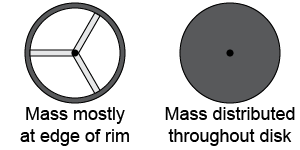|
Rotational inertia is at the heart of the rotation of rigid bodies. The moment of inertia of an object represents its rotational inertia about a particular axis. Moment of inertia depends not just on mass but also on the distribution of that mass. Even if a solid sphere and a hollow sphere have the same mass, they have different moments of inertia because their mass is distributed differently. Rolling objects possess not just kinetic energy but also rotational energy (sometimes called the kinetic energy of rotation). When rolling downhill, objects will be accelerated differently, depending on their moment of inertia. 
|
|
rotational energy, precession
|
|
|
|
Review problems and questions |
|
- In bowling, usually the bowling ball will initially slide down the lane without spinning. Partway down the lane, however, the ball begins to roll. What happens to the velocity of the ball when it begins to roll?

 |
Just before the ball begins to roll it has only kinetic energy, while just after it begins to roll it has both kinetic energy and rotational energy. If we assume negligible friction, by conservation of energy the energy before and after must be equal. Therefore some of the ball’s initial kinetic energy is converted into rotational energy. Since the ball now has less kinetic energy, its speed must decrease after it begins to roll. 
|
- What is the moment of inertia for each of the following? (Mass of the Earth: 6.0×1024 kg. Mass of the Moon: 7.3×1022 kg. Radius of the Earth: 6.4×106 m. Radius of the Moon: 1.7×106 m. Radius of the Earth’s orbit around the Sun: 1.5×1024 m. Radius of the Moon’s orbit around the Earth: 3.9×108 m.)
- Moon’s orbit around the Earth
- Earth’s orbit around the Sun
- rotation of the Moon about its axis
- rotation of the Earth about its axis

 |
Answer: - 1.1×1040 kg m2
- 1.4×1073 kg m2
- 8.4×1034 kg m2
- 9.8×1037 kg m2
Solution: -
-
- The moment of inertia of a rotating, solid sphere is ⅖mr2, so
-

- A beginning bowler pushed a 6 kg bowling ball so that it rolled down the lane without slipping at 2 m/s. How much work did the bowler do on the ball to start it rolling?

 |
Answer: The bowler did 16.8 J of work to roll the bowling ball.
Asked: work W done by the bowler to roll the bowling ball
Given: mass of the ball, m = 6 kg; (linear) velocity of the ball, v = 2 m/s
Relationships: rolling motion equation v = ωr; kinetic energy Ek = ½mv2;
rotational (kinetic) energy Ek = ½mv2; moment of inertia of a solid sphere, I = ⅖mr2
Solve: From the work–energy theorem, the work done is the change in the kinetic energy of the ball. In this case, the kinetic energy of the rolling ball is the sum of its (linear) kinetic energy and rotational (kinetic) energy: Rewrite the equation of rolling motion as ω = v/r, then substitute for this and the moment of inertia I = ⅖mr2 to get 
|
- Will a hoop or a solid disk be accelerated more when rolling down the same inclined plane? (Assume that the two objects have the same radius.)

 |
The solid disk will be accelerated more than the hoop (a hollow cylinder). The hoop has a larger moment of inertia, because more of its mass is located further from the axis of rotation. The hoop will therefore convert more of its initial gravitational potential energy into rotational energy, not linear kinetic energy. The solid disk will end up with more kinetic energy, which means that it has a higher velocity and was accelerated more. 
|

- You are considering two different designs for the wheel that forms part of a wheel-and-axle simple machine. Although both designs have the same mass, one puts most of the mass near the rim while the other distributes the mass evenly throughout the wheel. What are the advantages or disadvantages of each design if the input force will be applied to the axle?

 |
The design with most of the mass near the rim will have the largest moment of inertia, because more of the mass is located at larger distances from the axis of rotation. It will take more effort to start this design moving because it has more rotational inertia, so it is a worse design if you want to apply the minimum force at the axle. This design will also be more difficult to stop for the same reason, so it could be a better design if you wanted the wheel and axle to carry a lot of rotational inertia while it is moving. 
|
Take a Quiz | |
| |
|

